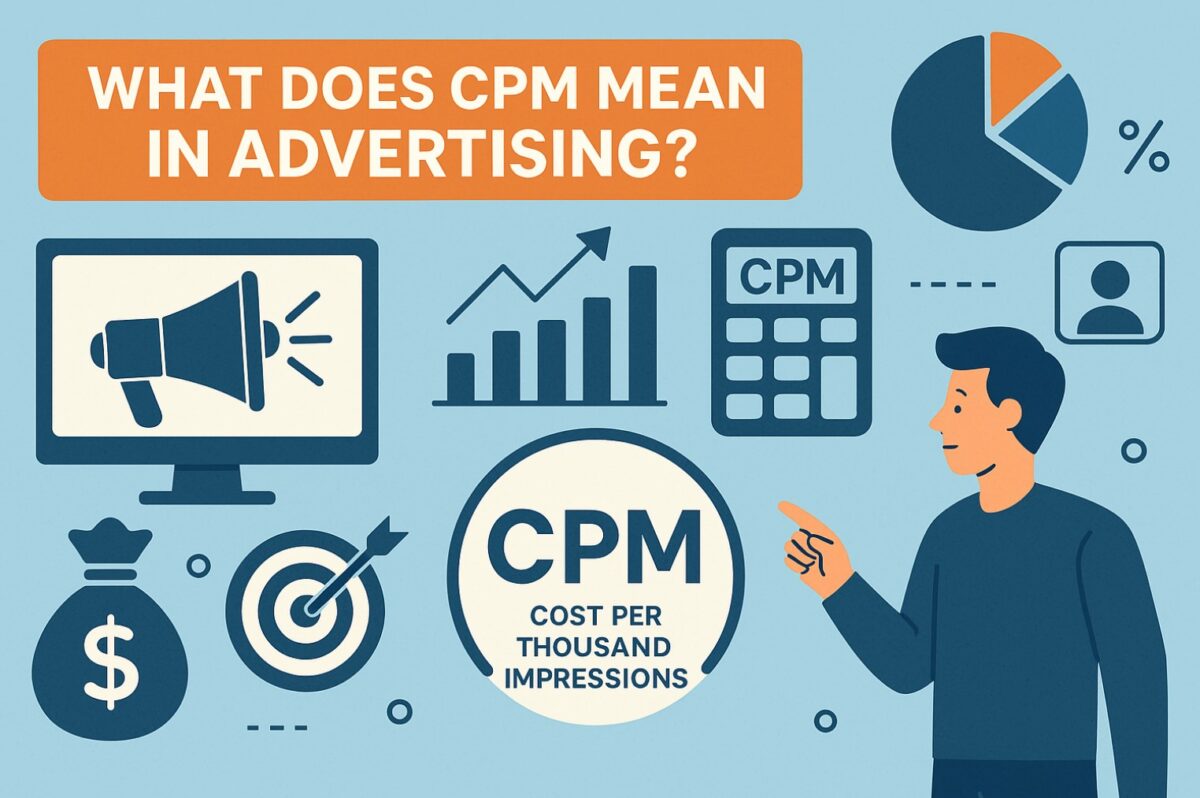
Navigating the world of digital advertising can be daunting. With numerous metrics and platforms, it’s easy to feel overwhelmed.
One key metric stands out: CPM, or Cost Per Mille. It’s crucial for understanding ad costs.
CPM measures the cost per thousand impressions. It’s a standard in both traditional and digital advertising.
Understanding CPM is vital for effective budget management. It helps in evaluating the cost-effectiveness of campaigns.
A CPM calculator simplifies this process. It allows marketers to quickly determine costs and plan budgets.
Knowing how to compute CPM can enhance strategic decision-making. It aids in comparing different advertising channels.
This guide will explore CPM calculators in detail. You’ll learn how to use them to optimize your campaigns.
By mastering CPM, you can streamline your advertising efforts. This leads to improved ROI and more efficient campaign management.
What Does CPM Mean in Advertising?
In advertising, CPM stands for Cost Per Mille. “Mille” is Latin for thousand. So, CPM represents the cost per thousand impressions.
An impression occurs each time an ad is viewed by a user. CPM is fundamental for tracking and budgeting in campaigns.
This metric helps you assess the efficiency of your advertising spend. Lower CPMs often indicate more cost-effective campaigns.
Advertisers use CPM as a benchmark across various platforms. It’s applicable to social media, display ads, and more.
Understanding CPM is crucial for strategic campaign planning. It provides insight into ad reach and cost-effectiveness.
Here are key aspects of CPM in advertising:
- Cost Measurement: Determines how much you’ll spend per 1,000 impressions.
- Budgeting: Helps allocate resources effectively.
- Comparative Analysis: Allows for the evaluation of different media channels.
- Reach Assessment: Offers a gauge of how widely your ad message is being seen.
Grasping what CPM means enables better decision-making in advertising strategies. It’s a cornerstone in the digital marketing world.
The CPM Formula: How to Compute Cost Per Mille
Calculating CPM is straightforward once you understand the formula. It involves dividing the total campaign cost by the total number of impressions.
The result is then multiplied by 1,000. This gives the cost per thousand impressions. Understanding this formula is vital for effective advertising management.
Here’s the CPM formula breakdown:
- Total Cost: The amount spent on the ad campaign.
- Total Impressions: The number of times the ad is viewed.
- Calculation: [ \text{CPM} = \left(\frac{\text{Total Cost}}{\text{Total Impressions}}\right) \times 1,000 ]
Correct computation of CPM ensures you can efficiently compare different campaigns. This enables you to identify which channels provide the most value.
Having this formula at your fingertips facilitates better budgeting and strategic decisions. Calculating CPM accurately helps you maximize your advertising investment. This understanding is crucial for optimizing your advertising reach and performance.
How to Use a CPM Calculator: Step-by-Step Guide
A CPM calculator simplifies campaign cost analysis. It’s a user-friendly tool that assists in determining the cost per thousand impressions.
To use a CPM calculator effectively, follow these steps:
- Input Total Campaign Cost: Enter the total amount spent on the ad campaign.
- Enter Total Impressions: Provide the number of ad impressions received.
After entering this data, the calculator will compute your CPM. Understanding these inputs is crucial for accurate results.
The formula inside a CPM calculator is the same as the manual method. However, using a tool accelerates the process, saving valuable time.
Using a CPM calculator allows marketers to quickly evaluate multiple campaigns. This aids in making data-driven decisions efficiently.
Here’s why using a CPM calculator is beneficial:
- Speed: Provides quick calculations without manual errors.
- Ease: Simple interface with easy-to-follow prompts.
Analyzing campaign costs with such tools leads to better strategic adjustments. It ensures you can allocate budgets where they’re most effective.
For a marketing manager, this means having more control over advertising efficiency. It’s crucial for optimizing ad spend and boosting overall ROI.
CPM in Digital Marketing: Why It Matters
CPM, or Cost Per Mille, is pivotal in digital marketing. It measures ad costs against impressions. This standard metric evaluates cost efficiency across platforms.
Why does CPM matter in marketing strategies? Here’s why:
- Budget Evaluation: CPM helps in assessing budget allocation efficiency.
- Performance Analysis: Offers insights into ad reach and effectiveness.
- Benchmarking: Enables comparison with industry standards.
A clear understanding of CPM benefits marketers. It aids in strategic decision-making and optimizing ad spend.
CPM is integral to programmatic advertising, helping automate ad placements. By mastering CPM, marketers enhance campaign management and drive better results. Recognizing CPM’s importance can transform advertising strategies, leading to superior campaign outcomes and a better return on investment.
CPM vs. Other Pricing Models: CPC, CPA, and eCPM
Digital advertising offers various pricing models beyond CPM. Understanding these alternatives is key for strategic planning.
CPC (Cost Per Click) charges advertisers only when their ad is clicked. It’s useful for campaigns focused on driving traffic.
CPA (Cost Per Action) bases charges on specific actions, like purchases. This model ensures you’re paying for desired outcomes.
eCPM (Effective CPM) represents revenue per thousand impressions. It standardizes comparison across different pricing models.
Here’s a quick comparison:
- CPM: Costs for every 1,000 impressions.
- CPC: Costs only for ad clicks.
- CPA: Costs based on completed actions.
Different models serve various campaign objectives. Selecting the right one depends on campaign goals, whether they’re brand awareness, engagement, or conversions. Each model’s effectiveness varies by campaign type and platform. By aligning pricing strategies with campaign goals, advertisers can enhance ROI and optimize their advertising spend.
Practical Examples: Calculating CPM for Real Campaigns
Understanding how to calculate CPM is crucial for effective campaign management. Let’s explore some real-life examples.
Imagine you’re running a video ad campaign. You’ve spent $2,000, and it generated 500,000 impressions. Using the CPM formula, you calculate:
[ \text{CPM} = \left( \frac{\text{Total Cost}}{\text{Total Impressions}} \right) \times 1,000 ]
So, the CPM here is:
[ \text{CPM} = \left( \frac{2,000}{500,000} \right) \times 1,000 = $4 ]
Here’s another scenario: A display ad campaign costs $800 and gets 120,000 impressions. Calculate the CPM:
- Total Cost: $800
- Total Impressions: 120,000
[ \text{CPM} = \left( \frac{800}{120,000} \right) \times 1,000 = $6.67 ]
These examples illustrate how to compute CPM efficiently. Knowing how to find CPM enables better comparison between campaigns. It also helps in optimizing budget allocation.
For any marketing manager, practicing with real numbers is invaluable. It builds confidence in managing ad spend effectively. Understanding these calculations transforms abstract concepts into actionable insights for successful advertising.
How to Calculate Impressions from CPM and Budget
Calculating the number of impressions from your CPM and budget is straightforward. This process aids strategic planning and budget allocation.
Start by knowing your total budget and desired CPM. For example, suppose you have a $5,000 budget and want a CPM of $10.
The formula to calculate impressions is:
[ \text{Total Impressions} = \left( \frac{\text{Budget}}{\text{CPM}} \right) \times 1,000 ]
Using the example above:
[ \text{Total Impressions} = \left( \frac{5,000}{10} \right) \times 1,000 = 500,000 ]
This means you can expect 500,000 impressions with a $5,000 budget at a $10 CPM. This calculation helps you forecast campaign reach accurately and align goals with budget considerations. Practicing these computations empowers marketing managers to make informed decisions tailored to specific campaigns.
Cost Per Impression and Cost Per Thousand: Related Metrics Explained
In digital marketing, understanding the relationship between cost per impression (CPI) and cost per thousand (CPM) is essential. Though related, they serve different purposes in measuring ad effectiveness.
CPI represents the cost advertisers pay each time their ad is shown once. It provides a granular view, revealing how much each individual impression costs.
On the other hand, CPM, or cost per mille, represents the cost for one thousand impressions. This metric offers a broader perspective, showing the overall efficiency of campaign spending.
To clarify, here’s a quick overview:
- CPI (Cost Per Impression): Cost for one ad display.
- CPM (Cost Per Thousand): Cost for a thousand ad displays.
Both metrics are vital. They offer insights into ad performance and spending, helping marketers optimize budget utilization effectively. Mastering these concepts allows for sound strategic decisions in campaign planning and execution.
Factors That Influence CPM Rates
Several factors impact CPM rates, making them fluctuate across campaigns. Understanding these can aid in better budget allocation.
Firstly, audience targeting plays a crucial role. Specific, niche audiences often command higher CPM due to their value to advertisers.
Next, ad placement matters significantly. Ads in premium locations like homepage takeovers or top banner placements usually incur higher CPM rates.
The time of year also affects rates. Key shopping seasons like Black Friday or holidays can drive demand and subsequently increase CPM.
Lastly, the type of content and platform used can influence CPM. Platforms with high engagement or sought-after content often demand premium rates.
To summarize, factors affecting CPM rates include:
- Audience specificity
- Ad placement quality
- Seasonal timing
- Platform and content desirability
Recognizing these variables helps in strategic decision-making to manage ad budgets optimally.
Using CPM Calculators to Optimize Campaigns
CPM calculators (mostly for popunders) are indispensable tools for enhancing campaign efficiency. They offer a straightforward way to assess your ad budget.
By entering your total campaign costs and estimated impressions, a CPM calculator quickly computes your cost per thousand impressions. This allows for immediate insights.
These calculators help identify underperforming strategies. By comparing CPM across channels, you can allocate more budget to cost-effective ones.
Strategic use of CPM calculators also aids in setting clearer goals. Understanding CPM variations leads to better media buying decisions.
Consider these benefits of CPM calculators:
- Rapid cost assessment
- Enhanced budget allocation
- Improved goal setting
To effectively utilize CPM calculators, consider integrating them into regular campaign analysis. This integration supports continuous optimization efforts.
In summary, CPM calculators streamline campaign management by providing vital cost metrics. Their use fosters data-driven decisions and can improve overall campaign performance.
Common Mistakes and How to Avoid Them
Missteps in using CPM calculators can lead to inefficient ad spending. It’s crucial to understand common errors and how to sidestep them effectively.
One frequent mistake is inputting inaccurate data. Ensure all cost and impression figures are precise to get reliable CPM results.
Another slip-up involves ignoring context. Analyzing CPM without considering industry benchmarks or campaign goals can mislead.
Avoid These Mistakes:
- Entering incorrect data
- Overlooking campaign context
- Failing to compare with benchmarks
By carefully checking inputs and considering broader metrics, you can avoid these pitfalls and make the most out of your advertising efforts.
CPM Benchmarks and Industry Standards
CPM benchmarks vary across industries and platforms, providing a guide for assessing ad performance. These standards help marketers gauge if their campaigns align with industry expectations.
Common sectors like retail and technology often have differing CPM averages. It’s wise to regularly update your knowledge about these variations.
Consider These Benchmarks:
- Retail: $5 – $15
- Technology: $20 – $35
- Social Media: Varies significantly
Adapting to these benchmarks can help you make informed decisions, ensuring your campaigns are both competitive and cost-effective.
Automating CPM Analysis for Efficient Campaign Management
Automating CPM analysis can significantly enhance campaign management. Automation tools help marketers save time by streamlining data collection and analysis.
By integrating CPM calculators with automation software, you can gain real-time insights. These insights help in adjusting campaigns on-the-go for better performance.
Benefits of Automating CPM Analysis:
- Quicker data processing
- Real-time performance adjustments
- Improved ROI through precise targeting
Utilizing automation ensures your advertising efforts are both efficient and strategic. This enables a more responsive approach to changing market dynamics.
Key Takeaways for Marketing Managers
Understanding CPM is vital for effective advertising. Grasping this metric can streamline your budget allocation. It also enhances your strategic decision-making.
CPM calculators simplify ad cost evaluations. They provide essential insights into the cost-effectiveness of your campaigns. Utilizing these tools aids in maximizing your advertising budget.
Essential Points:
- CPM gives clarity on cost per thousand impressions.
- Calculators aid in budgeting and performance assessments.
- Automation of CPM analysis optimizes campaigns effectively.
Integrating CPM analysis into your workflow can increase your return on investment. Knowledge of CPM and its related tools helps in navigating the complex world of digital advertising.
Conclusion: Mastering CPM for Better ROI
Mastering CPM offers a significant advantage in achieving better ROI for your advertising campaigns. By understanding and utilizing CPM calculations, you gain precise control over your advertising spend, allowing for more strategic budget allocation.
Adopting CPM calculators and automation tools streamlines your campaign management. This not only enhances efficiency but also ensures that your advertising efforts yield tangible results. With informed decisions, you can consistently optimize your strategies for improved performance.




